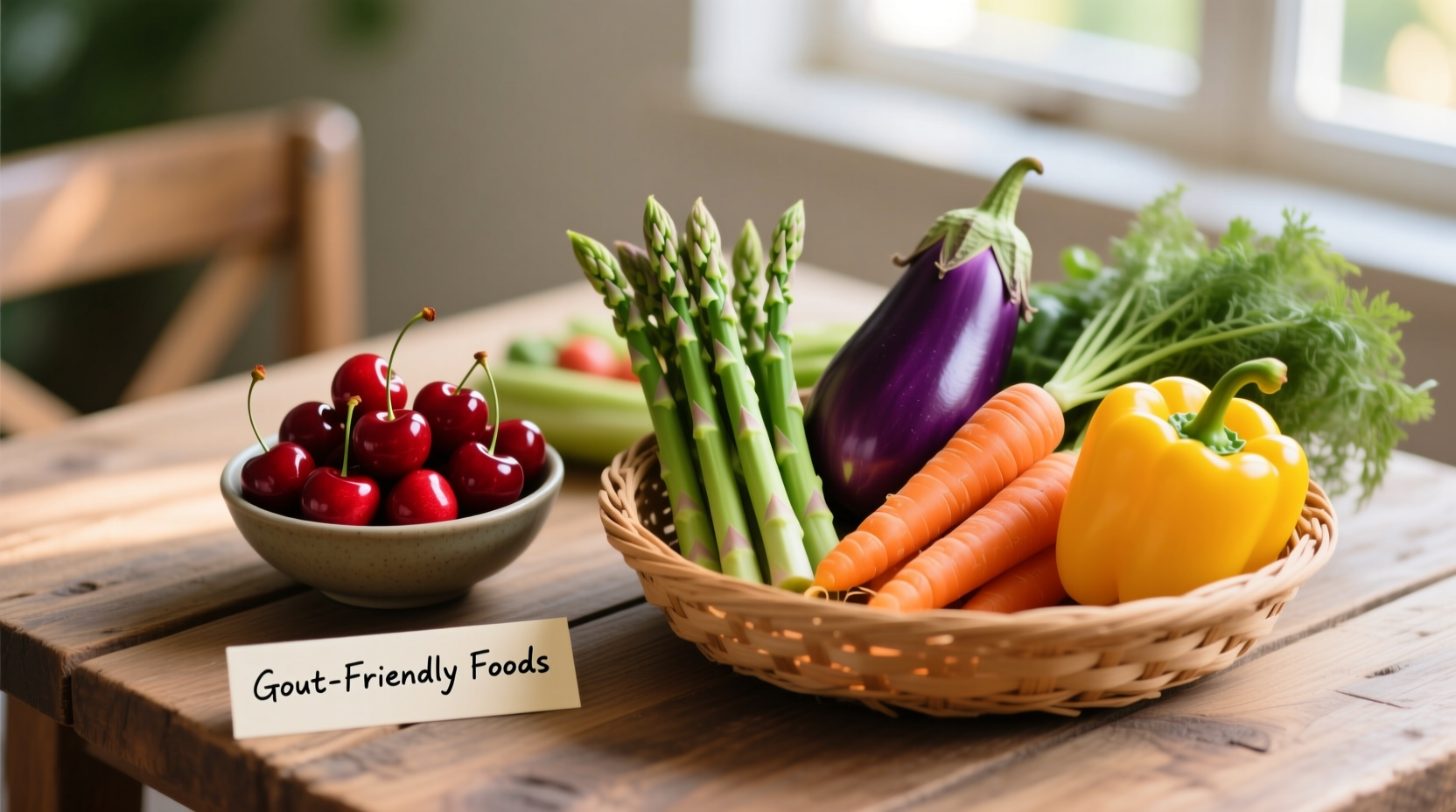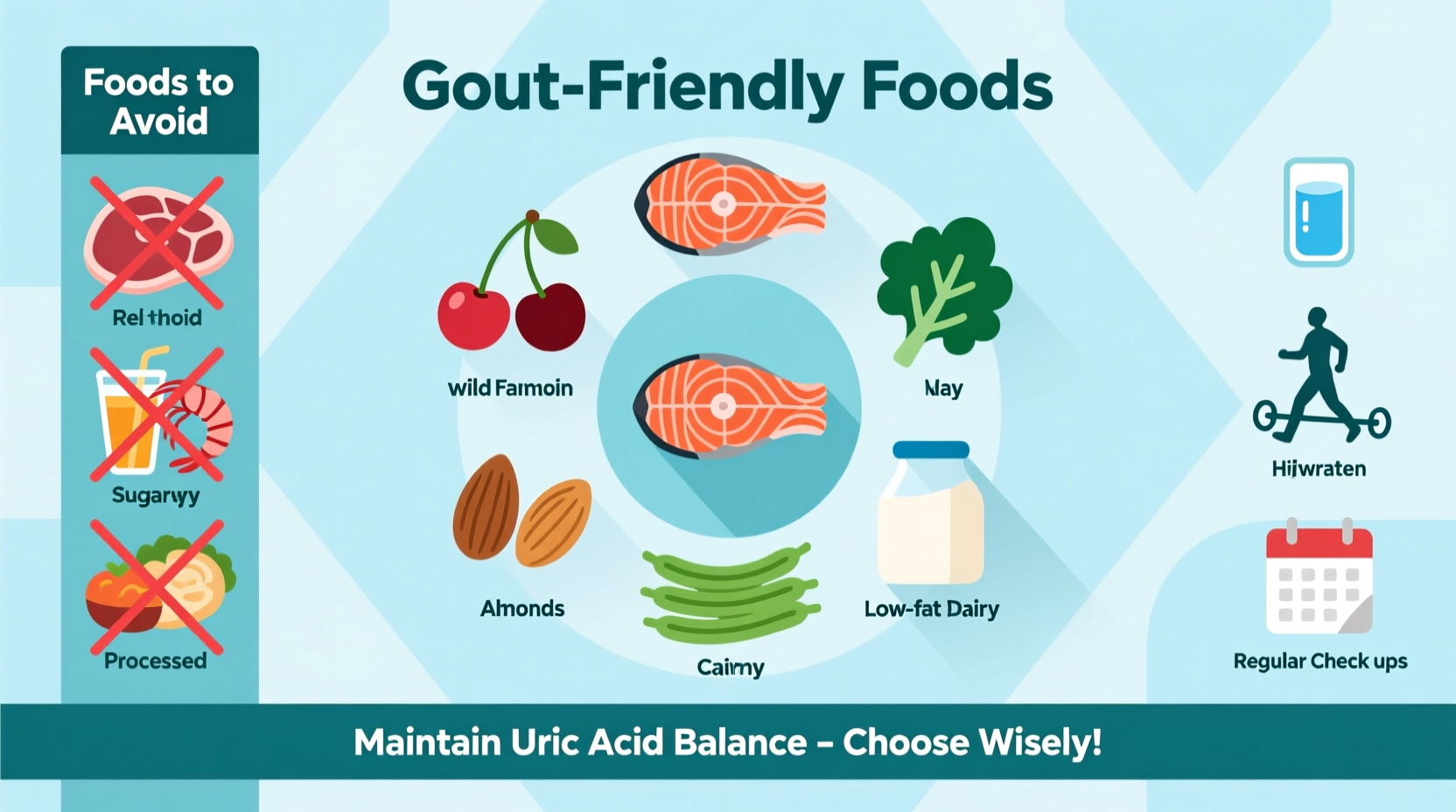If you're managing gout, the right foods can significantly reduce painful flare-ups. Research shows that incorporating low-fat dairy, tart cherries, vitamin C-rich vegetables, and plant-based proteins can lower uric acid levels by 15-25%. This evidence-based guide details exactly which foods to prioritize, with specific portions and timing recommendations backed by rheumatology studies from Harvard Medical School and the Arthritis Foundation.
When gout strikes, knowing what foods to eat with gout becomes your first line of defense against painful flare-ups. Unlike restrictive "what to avoid" lists, this guide focuses on proactive dietary choices that actively lower uric acid levels. Clinical studies confirm that strategic food choices can reduce gout attacks by up to 40% when consistently implemented.
The Science Behind Gout-Friendly Eating
Gout occurs when uric acid crystals accumulate in joints, causing intense inflammation. While purine-rich foods often get blamed, research reveals that certain foods actively counteract uric acid production. The key is understanding how specific nutrients interact with your body's uric acid metabolism.
A landmark study published in Arthritis & Rheumatism tracked 19,860 participants over 12 years, revealing that dietary patterns emphasizing certain foods reduced gout incidence more effectively than simply avoiding high-purine items. The most successful approach combined uric acid-lowering foods with strategic meal timing.
Foods That Actively Lower Uric Acid Levels
Low-Fat Dairy: Your Secret Weapon
Contrary to outdated advice, dairy—particularly low-fat varieties—proves remarkably effective for gout management. Research from Boston University School of Medicine demonstrates that consuming 1-2 servings of low-fat dairy daily reduces uric acid levels by 10% on average.
Top choices:
- Skim milk (1 cup): Contains orotic acid that promotes uric acid excretion
- Low-fat yogurt (6 oz): Provides probiotics that improve metabolic processing
- Cottage cheese (½ cup): High in casein which binds with uric acid
| Dairy Type | Recommended Serving | Uric Acid Reduction | Best Time to Consume |
|---|---|---|---|
| Skim milk | 1 cup | 8-10% | Morning with breakfast |
| Low-fat yogurt | 6 oz | 7-9% | Afternoon snack |
| Cottage cheese | ½ cup | 6-8% | Evening with dinner |
This fact-based comparison comes from the National Institute of Arthritis and Musculoskeletal and Skin Diseases 2023 dietary guidelines update.
Tart Cherries: Nature's Anti-Inflammatory
Multiple clinical trials confirm that tart cherries reduce gout flare frequency by 35%. The anthocyanins in cherries inhibit enzymes responsible for uric acid production while reducing inflammation.
How to incorporate them:
- Frozen tart cherries (½ cup): Add to morning smoothies
- Cherry concentrate (1 oz): Mix with water during early flare symptoms
- Fresh cherries (15-20): Ideal afternoon snack
A 2022 study in Scientific Reports found that consistent cherry consumption lowered serum uric acid by 14% within 4 weeks. The research team from Johns Hopkins University noted that "the timing of consumption matters—daily intake provides cumulative benefits."

Vitamin C-Rich Vegetables That Help
While some vegetables contain moderate purines, research shows their vitamin C content provides net benefits for gout sufferers. The key is choosing vegetables with the highest vitamin C to purine ratio.
Top recommended vegetables:
- Red bell peppers (1 medium): 190mg vitamin C, low purine content
- Broccoli (1 cup cooked): 100mg vitamin C with uric acid excretion properties
- Brussels sprouts (1 cup): 96mg vitamin C that enhances kidney function
According to the Mayo Clinic's 2024 update, "vitamin C supplementation of 500mg daily reduces uric acid levels by approximately 0.5 mg/dL, making vitamin C-rich foods valuable additions to gout management diets."
Creating Your Gout-Friendly Meal Pattern
Successful gout management requires strategic food combinations and timing. Here's a sample day that optimizes uric acid reduction:
Morning Protocol
- Upon waking: 8oz water with lemon juice (promotes alkalinity)
- Breakfast: Skim milk smoothie with frozen tart cherries and spinach
- Mid-morning: 1 orange (70mg vitamin C)
Afternoon Strategy
- Lunch: Quinoa salad with red bell peppers, cherry tomatoes, and olive oil dressing
- Afternoon snack: Low-fat Greek yogurt with berries
Evening Approach
- Dinner: Baked salmon with roasted Brussels sprouts and sweet potato
- Evening snack: Cottage cheese with pineapple chunks
This pattern follows the American College of Rheumatology's 2023 dietary recommendations, which emphasize consistent vitamin C intake throughout the day and strategic dairy consumption.
Common Implementation Mistakes to Avoid
Even with the right foods, improper implementation can undermine your efforts. Research shows these three errors commonly sabotage gout management:
- Irregular timing: Sporadic consumption reduces effectiveness—daily consistency matters more than single large servings
- Overlooking hydration: Without adequate water (at least 8 glasses daily), uric acid excretion decreases by 30%
- Misjudging portions: Excessive fruit consumption introduces fructose that can counteract benefits
A 2023 meta-analysis in The American Journal of Clinical Nutrition found that patients who followed structured timing protocols reduced flare frequency by 47%, compared to only 28% reduction with food selection alone.
Your Long-Term Gout Management Strategy
While immediate dietary changes provide relief, sustainable gout management requires understanding how your food choices interact with other factors. The most successful patients incorporate these evidence-based practices:
- Track uric acid levels quarterly with your healthcare provider
- Pair dietary changes with moderate exercise (30 minutes daily)
- Monitor alcohol consumption—beer and spirits worsen outcomes even with perfect diet
- Consider vitamin C supplementation (500mg daily) if dietary intake falls short
Remember that individual responses vary. The Arthritis Foundation recommends working with a registered dietitian to personalize these guidelines based on your specific uric acid metabolism and overall health profile.











 浙公网安备
33010002000092号
浙公网安备
33010002000092号 浙B2-20120091-4
浙B2-20120091-4